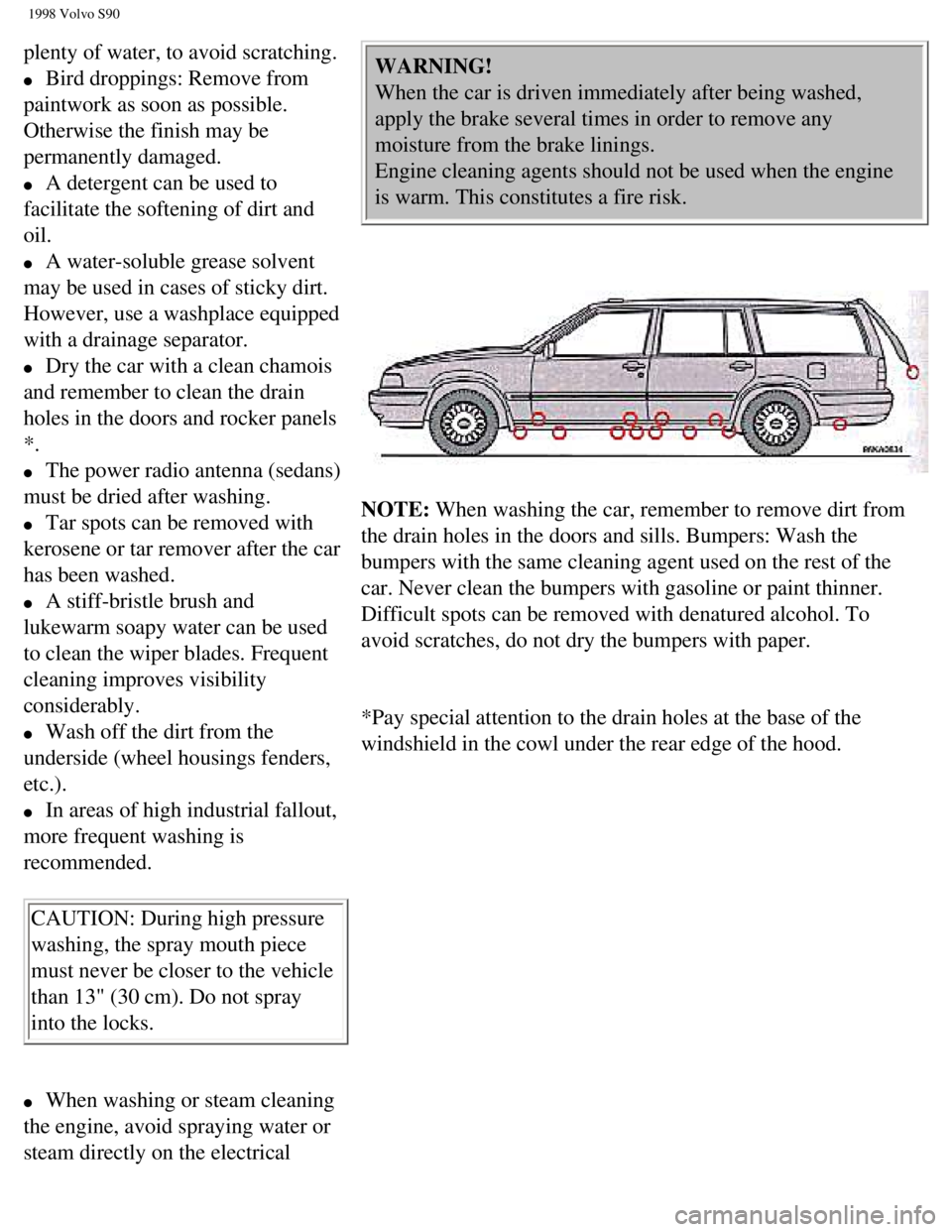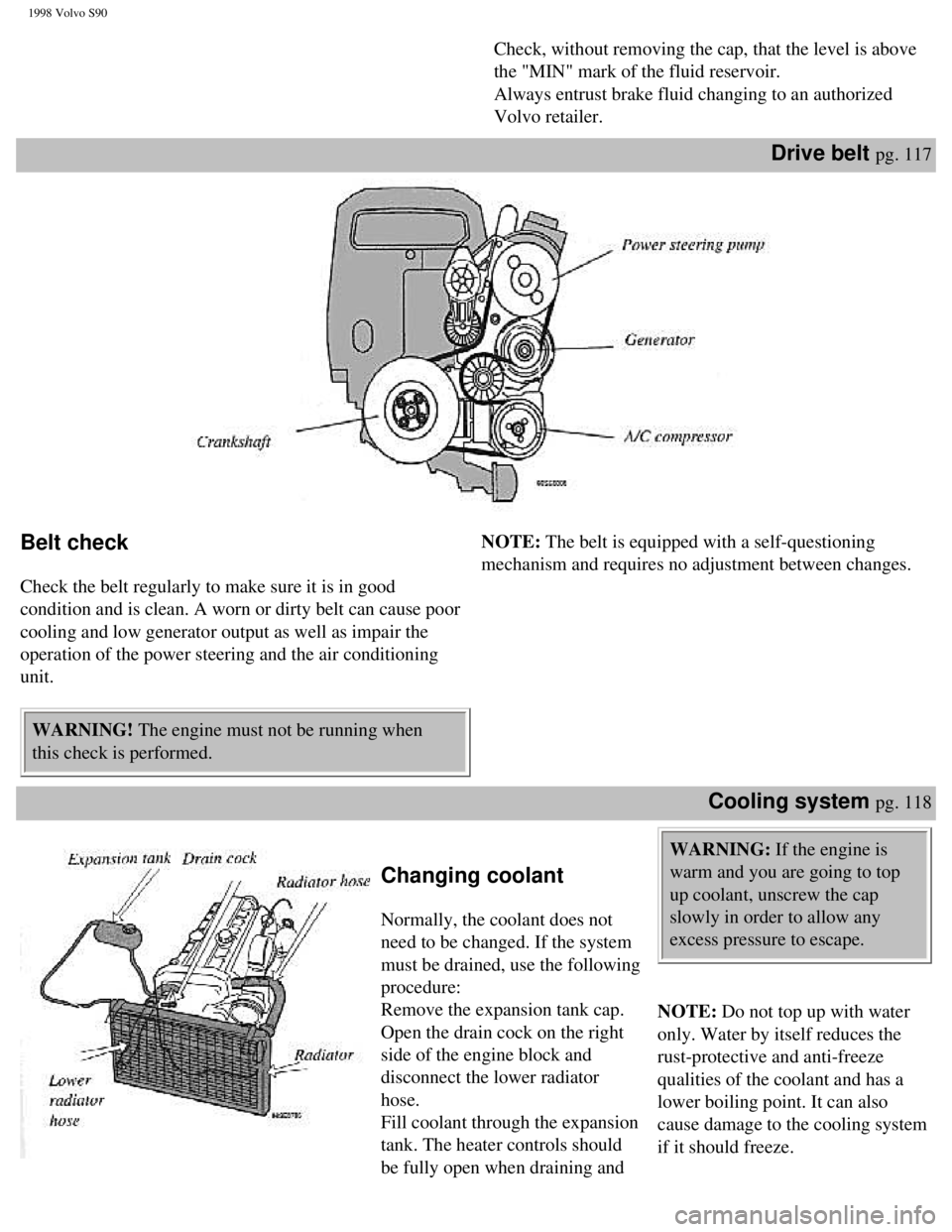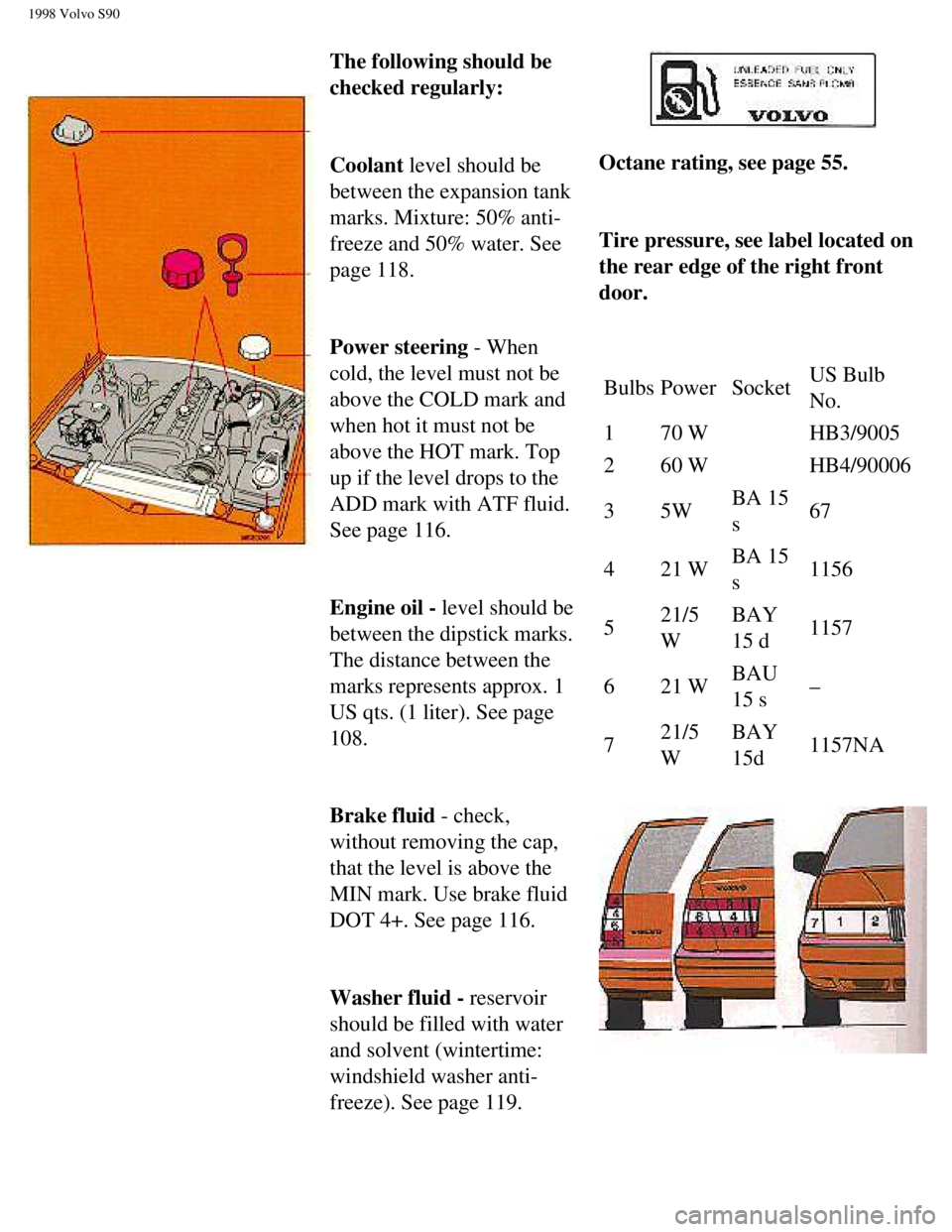Page 80 of 175

1998 Volvo S90
cold-weather oil for hard driving or in warm
weather. See section "Engine oil" for more
information.
l The load placed on the battery is greater during
the winter since the heater, windshield wipers,
lighting etc. are used more often. Moreover, the
capacity of the battery decreases as the
temperature drops. In very cold weather, a poorly
charged battery can freeze and be damaged. It is
therefore advisable to check the state of charge
more frequently and spray an anti-rust oil on the
battery posts.
l Volvo recommends the use of snow tires on all
four wheels for winter driving - see section
"Wheels and tires".
l To prevent the washer reservoir from freezing,
add washer solvents containing antifreeze. This is
important since dirt is often splashed on the
windshield during winter driving, thus requiring
frequent use of the washers and wipers.
functions when the transmission is in reverse.
Also see "Winter/Wet" mode on page 59.
Winter/Wet mode
Enhanced Vehicle Traction
This mode may be selected for starting/moving
off on slippery roads or to lower downshift speeds
if the transmission is in "L".
Mode W
*In position D, the gearbox starts in third gear and
changes up to fourth gear.
*In position 3, second gear is locked and there is
no change up to third gear. In position L, first gear
is locked.
*These positions always offer the kick-down
feature.
Long distance trip pg. 70
Before a long distance trip
It is always worthwhile to have your car checked at a Volvo retailer
before driving long distances. Your retailer will also be able to supply\
you with bulbs, fuses, spark plugs and wiper blades for your use in the \
event that problems occur.
If you prefer to check the car yourself, please note the following:
l Check that the engine runs smoothly and that fuel consumption is
normal.
l Check engine oil, coolant levels, and for possible fuel leakage.
l Check transmission oil level and rear axle for leakage.
l Check condition of drive belts.
l Check state of charge of battery.
l Examine tires carefully (the spare tire as well), and replace those
that are worn. Check tire pressures.
l The brakes, front wheel alignment, and steering gear should be
checked by your Volvo retailer only.
l Check all lights, including high beams.
file:///K|/ownersdocs/1998/1998_SV90/98S90_067.htm (4 of 5)12/30/2006 \
1:52:43 PM
Page 109 of 175

1998 Volvo S90
plenty of water, to avoid scratching.
l Bird droppings: Remove from
paintwork as soon as possible.
Otherwise the finish may be
permanently damaged.
l A detergent can be used to
facilitate the softening of dirt and
oil.
l A water-soluble grease solvent
may be used in cases of sticky dirt.
However, use a washplace equipped
with a drainage separator.
l Dry the car with a clean chamois
and remember to clean the drain
holes in the doors and rocker panels
*.
l The power radio antenna (sedans)
must be dried after washing.
l Tar spots can be removed with
kerosene or tar remover after the car
has been washed.
l A stiff-bristle brush and
lukewarm soapy water can be used
to clean the wiper blades. Frequent
cleaning improves visibility
considerably.
l Wash off the dirt from the
underside (wheel housings fenders,
etc.).
l In areas of high industrial fallout,
more frequent washing is
recommended.
CAUTION: During high pressure
washing, the spray mouth piece
must never be closer to the vehicle
than 13" (30 cm). Do not spray
into the locks.
l When washing or steam cleaning
the engine, avoid spraying water or
steam directly on the electrical
WARNING!
When the car is driven immediately after being washed,
apply the brake several times in order to remove any
moisture from the brake linings.
Engine cleaning agents should not be used when the engine
is warm. This constitutes a fire risk.
NOTE: When washing the car, remember to remove dirt from
the drain holes in the doors and sills. Bumpers: Wash the
bumpers with the same cleaning agent used on the rest of the
car. Never clean the bumpers with gasoline or paint thinner.
Difficult spots can be removed with denatured alcohol. To
avoid scratches, do not dry the bumpers with paper.
*Pay special attention to the drain holes at the base of the
windshield in the cowl under the rear edge of the hood.
file:///K|/ownersdocs/1998/1998_SV90/98S90_097.htm (4 of 6)12/30/2006 \
1:52:47 PM
Page 118 of 175
1998 Volvo S90
1) Replace at 100,000 miles (160,000 km).
2) Brake fluid should be changed at owner request every second year (o\
nce a year if the car is driven in
mountainous areas or in areas with high humidity).
The following items should be checked weekly by the driver (it takes on\
ly a few minutes):
Engine oil level Windshield wipers
Brake fluid level Level of windshield washer fluid
Radiator coolant level
Tire pressure (all five tires)
Operation of all lights
Horns
The following should also be carried out at regular intervals:
Washing
Polishing
Cleaning
Contents | Top of Page
file:///K|/ownersdocs/1998/1998_SV90/98S90_103.htm (7 of 7)12/30/2006 \
1:52:48 PM
Page 127 of 175

1998 Volvo S90
Check, without removing the cap, that the level is above
the "MIN" mark of the fluid reservoir.
Always entrust brake fluid changing to an authorized
Volvo retailer.
Drive belt pg. 117
Belt check
Check the belt regularly to make sure it is in good
condition and is clean. A worn or dirty belt can cause poor
cooling and low generator output as well as impair the
operation of the power steering and the air conditioning
unit.
WARNING! The engine must not be running when
this check is performed. NOTE: The belt is equipped with a self-questioning
mechanism and requires no adjustment between changes.
Cooling system pg. 118
Changing coolant
Normally, the coolant does not
need to be changed. If the system
must be drained, use the following
procedure:
Remove the expansion tank cap.
Open the drain cock on the right
side of the engine block and
disconnect the lower radiator
hose.
Fill coolant through the expansion
tank. The heater controls should
be fully open when draining and
WARNING: If the engine is
warm and you are going to top
up coolant, unscrew the cap
slowly in order to allow any
excess pressure to escape.
NOTE: Do not top up with water
only. Water by itself reduces the
rust-protective and anti-freeze
qualities of the coolant and has a
lower boiling point. It can also
cause damage to the cooling system
if it should freeze.
file:///K|/ownersdocs/1998/1998_SV90/98S90_114.htm (3 of 5)12/30/2006 \
1:52:50 PM
Page 174 of 175

1998 Volvo S90
The following should be
checked regularly:
Coolant level should be
between the expansion tank
marks. Mixture: 50% anti-
freeze and 50% water. See
page 118.
Power steering - When
cold, the level must not be
above the COLD mark and
when hot it must not be
above the HOT mark. Top
up if the level drops to the
ADD mark with ATF fluid.
See page 116.
Engine oil - level should be
between the dipstick marks.
The distance between the
marks represents approx. 1
US qts. (1 liter). See page
108.
Brake fluid - check,
without removing the cap,
that the level is above the
MIN mark. Use brake fluid
DOT 4+. See page 116.
Washer fluid - reservoir
should be filled with water
and solvent (wintertime:
windshield washer anti-
freeze). See page 119.
Octane rating, see page 55.
Tire pressure, see label located on
the rear edge of the right front
door.
Bulbs Power Socket US Bulb
No.
1 70 W HB3/9005
2 60 W HB4/90006
3 5W BA 15
s 67
4 21 W BA 15
s 1156
5 21/5
W BAY
15 d
1157
6 21 W BAU
15 s –
7 21/5
W BAY
15d
1157NA
file:///K|/ownersdocs/1998/1998_SV90/98S90_161.htm (6 of 7)12/30/2006 \
1:52:56 PM